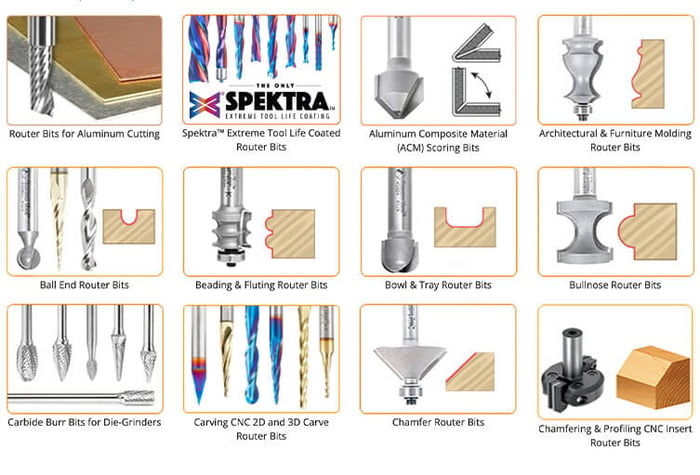
Router Bits for Beginners
If you’re just beginning your woodworking journey, understanding the essential tools is crucial for mastering the craft. Among the array of tools at your disposal, router bits play a pivotal role in shaping and detailing wood to perfection. From straight bits to specialty bits, each type serves a distinct function in the woodworking process.
In this comprehensive guide, we will explore the various types of router bits, delve into the best options for beginners, provide insights on their usage, offer safety tips, and help you choose the right router bit for your projects. We will discuss the maintenance and care required to ensure the longevity of your router bits. Whether you’re a novice woodworker or an experienced craftsman, this article will equip you with the knowledge and expertise needed to make the most of your router bits. So, let’s embark on this journey to unravel the world of router bits and empower your woodworking endeavors.
What Are Router Bits?
Router bits are woodworking tools used with a router to create various shapes, profiles, and cuts in different materials, serving as essential components for woodworking projects.
They come in a wide range of types, each designed for specific applications such as edging, grooving, and shaping. Straight bits are commonly used for cutting straight lines, while spiral bits are ideal for hollowing out materials. Their versatility allows for intricate detailing and precision, making them indispensable for professionals and hobbyists alike.
When selecting router bits, it's important to consider the material being worked on, as certain bits may be better suited for wood, plastic, or metal. Users should ensure proper speed and feed rates to achieve clean and accurate cuts.
Types of Router Bits
Router bits come in various types, each designed for specific cutting, shaping, or detailing tasks, including straight cut, corner rounding, edge forming, dovetail, and beading bits, catering to the diverse needs of woodworking projects.
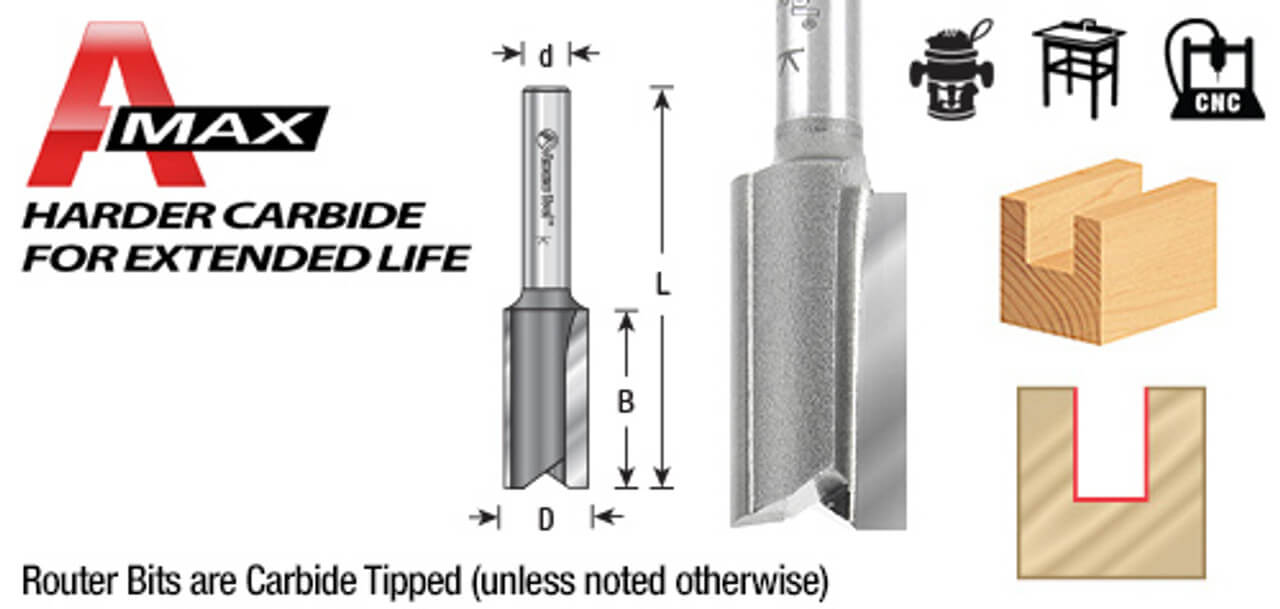
Straight Bits
Straight bits are fundamental router bits used for straight-line cutting and grooving in woodworking, available in a range of shank sizes and cutting diameters to accommodate diverse project requirements.
They are often favored for their versatility and precision, making them suitable for creating dadoes, rabbets, and other joinery cuts.
Their sharp edges and sturdy construction allow them to effortlessly cut through different wood types, including hardwoods, softwoods, and composite materials. Their compatibility with various routing machines and ability to produce clean, smooth edges make them indispensable tools for professional woodworkers and DIY enthusiasts alike.
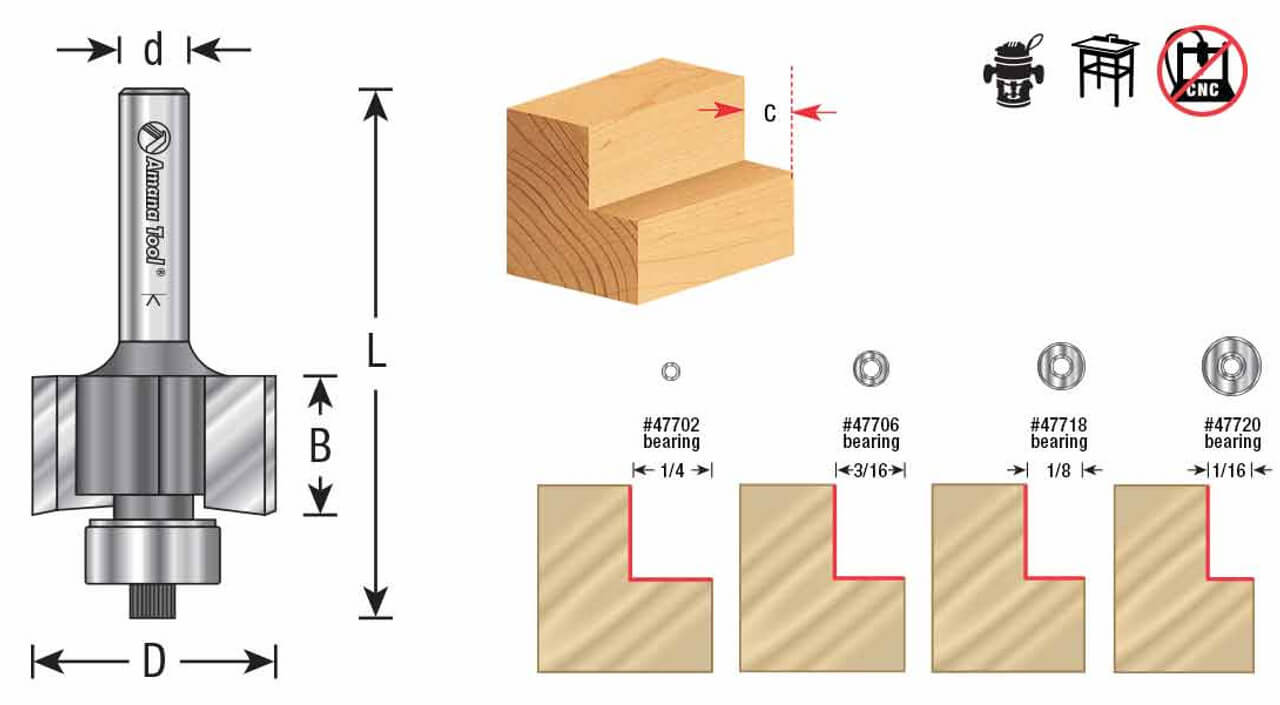
Rabbeting Bits
Rabbeting bits are specialized router bits primarily used for jointing and forming rabbets in woodworking projects, featuring durable carbide construction and various shank options for enhanced versatility.
These bits are designed to create precise joints by removing a specific amount of material, resulting in clean and tight-fitting connections. The carbide material used in the construction of rabbeting bits ensures long-lasting sharpness and durability, making them suitable for a wide range of woodworking materials, including hardwoods, softwoods, and plywood.
With shank variations such as 1/4 inch and 3/4 inch, these bits are compatible with a variety of routers, providing flexibility for different routing applications. Whether it's creating a rabbet joint for cabinet doors or shelves, these bits offer reliable performance and accuracy in woodworking projects.
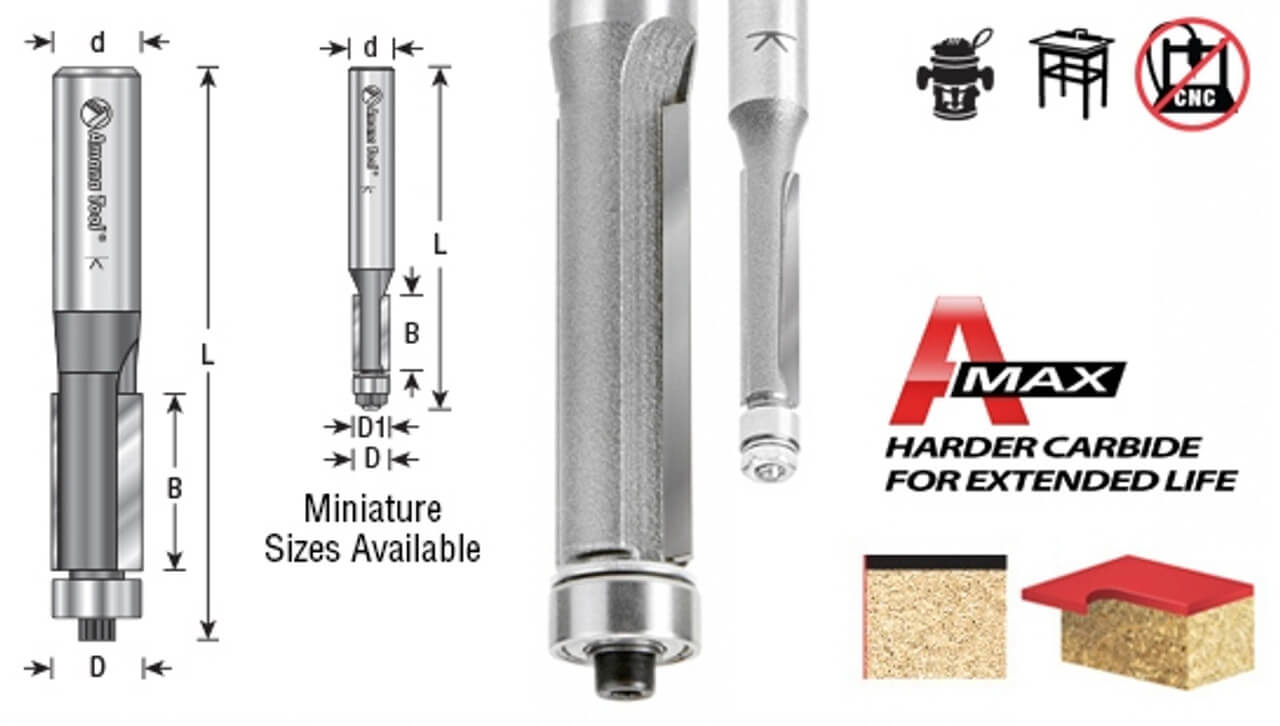
Flush Trim Bits
Flush trim bits are essential for precise trimming and shaping of edges, following templates or bearing-guided patterns, making them indispensable for achieving accurate profiles and cuts in woodworking projects.
These versatile tools are widely used for duplicating the shape of a template onto a workpiece, ensuring exact replication of intricate designs and patterns. Their precision allows woodworkers to create smooth, uniform edges and contours by seamlessly matching the template contours.
Flush trim bits are highly effective in flush cutting veneers and laminates, ensuring seamless, professional-looking finishes. The bearing-guided feature enables controlled cutting along the edge of a template, delivering consistent results and maintaining the integrity of the original design. With their applications in template-based routing, flush trim bits are instrumental in achieving precision and consistency in woodworking craftsmanship.

Chamfer Bits
Chamfer bits are specialized router bits designed for creating beveled or chamfered edges and surfaces in woodworking, offering precise control over angled cuts and edge detailing for various materials.
These versatile tools can be used to add decorative edges to furniture, trim, and molding, while also being essential for creating angled joints and precise bevels for a professional finish. Whether working with hardwood, softwood, or composite materials, chamfer bits provide consistent and clean results, making them indispensable for woodworkers seeking to elevate the quality and craftsmanship of their projects.

Cove Bits
Cove bits are essential for crafting concave profiles and curved cuts in woodworking, enabling the creation of unique and intricate designs in various materials, enhancing the aesthetic appeal of woodworking projects.
These versatile bits come in various sizes, allowing woodworkers to achieve different levels of depth and intricacy in their designs. They are particularly useful for creating decorative edges on furniture, cabinetry, and other woodworking projects.
Whether working with hardwoods, softwoods, or composite materials, cove bits can produce smooth and precise results, adding a touch of elegance to any piece. Their ability to shape concave profiles with precision makes them indispensable tools for woodworkers seeking to elevate their craft.
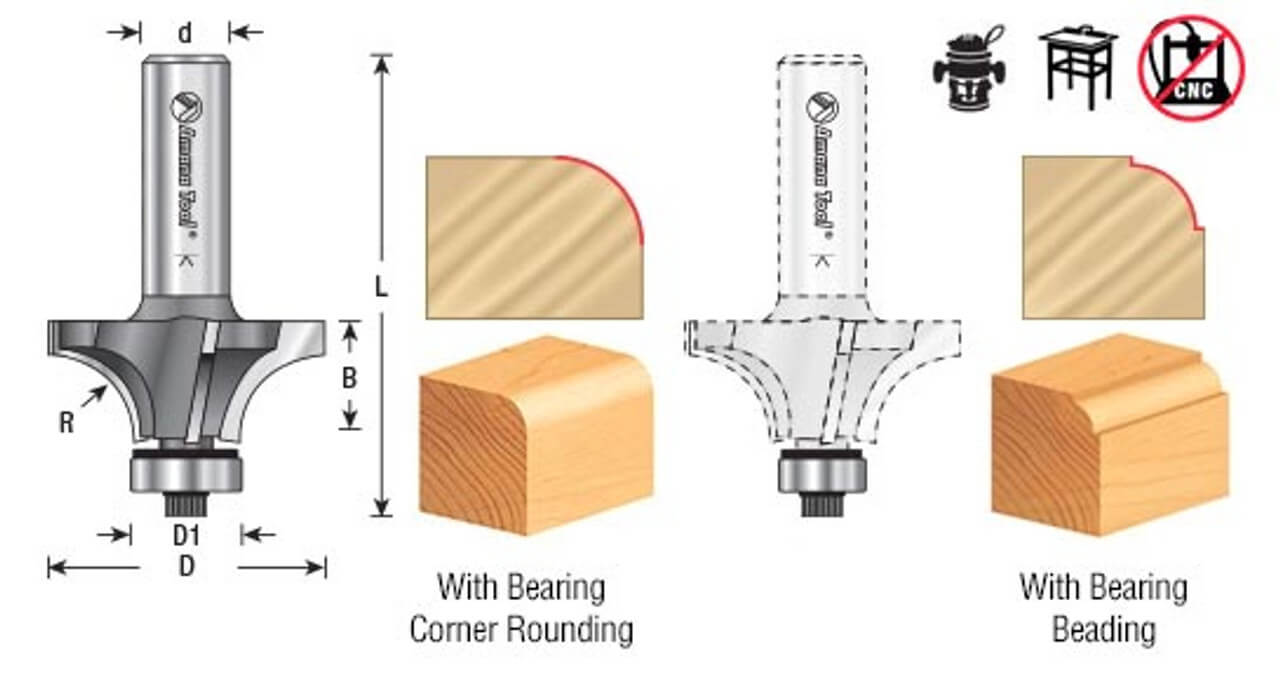
Roundover Bits
Roundover bits (also known as corner-round bits) are essential for creating rounded, bull-nose edges and detailing in woodworking, providing a seamless and elegant finish to various material edges, enhancing the visual appeal of woodworking projects.
These versatile bits are specifically designed to add a soft, curved edge to wood, laminates, and even plastics, effectively eliminating sharp corners and enhancing the safety and aesthetic of the finished workpiece. The roundover bits can be used with handheld or table-mounted routers, allowing woodworkers to achieve consistent, professional-looking results across a wide range of projects and materials.
Their ability to create smooth, rounded edges and profiles makes them indispensable for achieving a polished and refined look in edge treatments and material-specific detailing.

Dovetail Bits
Dovetail bits are crucial for crafting strong and decorative dovetail joints in woodworking, offering precise control and versatility for creating interlocking corner connections in various materials.
These bits are specifically designed to cut the tails and pins of the dovetail joint. Their unique shape allows for a snug fit and ensures that the joint can withstand stress and pulling forces. Woodworkers often use dovetail bits to create furniture, cabinets, drawers, and other wooden items that require strong, durable joints.
Dovetail bits can be used with different types of wood, such as hardwoods and softwoods, making them highly versatile for a variety of woodworking projects.

Beading Bits
Beading bits are essential for crafting decorative bead profiles and detailing in woodworking, allowing for the creation of intricate and embellished designs on various material surfaces, enhancing the aesthetic appeal of woodworking projects.
They offer a versatile range of decorative potential, making them perfect for creating intricate detailing, adding depth, and enriching the overall aesthetic of furniture, cabinets, and other woodworking projects. These bits can be used with different types of wood, allowing for material-specific embellishments that enhance the natural grain and texture, providing a unique visual appeal.
Whether it's traditional designs or modern styles, beading bits enable woodworkers to achieve custom decorative profiling and unique embellishments that elevate the overall appearance of their creations.
Edge Forming Bits
Edge forming bits are versatile tools for shaping and detailing the edges of woodworking materials, allowing for the creation of diverse profiles and decorative designs while ensuring precision and safety in the routing process.
These bits can be used for creating classic edge profiles such as round-over, chamfer, cove, and ogee, as well as intricate designs including beading and fluting. It's important to consider safety measures such as using the appropriate feed direction and controlling the workpiece firmly to prevent kickbacks.
Understanding the proper speed settings for different wood types and profiles is crucial to achieve desired results and maintain a safe workshop environment.
Specialty Bits
Specialty bits encompass a range of unique router bits designed for specific, custom cuts and profile creations in woodworking, offering tailored solutions for intricate, precise, and specialized routing tasks.
They are indispensable for woodworking projects that require custom routing and specialized profiles. These specialty bits are crafted to meet the demands of intricate designs, offering unparalleled precision and control. Woodworkers can rely on these specialized tools to achieve unique cuts and complex profiles, elevating the quality and detail of their work. From creating custom moldings to crafting detailed inlays, specialty bits unlock a world of possibilities in woodworking, empowering craftsmen to bring their creative visions to life.
What Are the Best Router Bits for Beginners?
Choosing the best router bits for beginners involves considering factors such as wood types, project requirements, budget constraints, and compatibility with entry-level routers, ensuring a seamless and rewarding woodworking experience for novice enthusiasts.
Wood compatibility is a crucial aspect to keep in mind as different router bits are suitable for specific wood types. Beginners should opt for budget-friendly options without compromising on quality. Entry-level woodworking projects often require versatile router bits that can handle various cutting tasks, making multi-purpose sets a practical choice.
It's also advisable for beginners to invest in a starter set that includes commonly used router bits, providing a solid foundation for their woodworking journey without breaking the bank.
How to Use Router Bits?
Mastering the usage of router bits in woodworking involves understanding various techniques such as:
- Edge forming, which entails creating decorative edges and profiles on workpieces, offering endless design possibilities.
- Trimming, which involves trimming the edges of the workpiece, ensuring clean and precise cuts.
- Jointing, which aims to create seamless connections between materials, enhancing structural integrity.
- Template-guided routing, which allows for consistent shaping and cutting by guiding the router along a template, delivering accurate and repeatable results.
These techniques are crucial for achieving professional-quality results while maximizing safety. Template-guided routing allows for consistent shaping and cutting by guiding the router along a template, delivering accurate and repeatable results
Safety Tips for Using Router Bits
Adhering to safety protocols when using router bits is crucial to prevent accidents and ensure the longevity of both the router bits and the woodworking equipment, involving techniques, maintenance, cleaning, and proper storage practices to safeguard the user and the tools.
Proper safety techniques include using appropriate eye and ear protection, ensuring the work area is well-lit and free from clutter, and always keeping hands away from the cutting area.
Maintenance requirements involve regularly inspecting the router bits for any signs of wear or damage, and ensuring they are properly sharpened and balanced. Cleaning procedures should include removing any wood chips or debris from the bits after use, while proper storage practices involve keeping the router bits in a secure and organized manner to prevent any accidental damage or injury.
How to Choose the Right Router Bit for Your Project?
Selecting the right router bit for a woodworking project involves considerations such as material compatibility, router specifications, shank sizes, and cutting profiles, ensuring optimal performance and precision in shaping and detailing tasks.</p><p>It's essential to match the router bit material with the wood you're working with; for instance, carbide-tipped bits are suitable for hardwoods, while high-speed steel bits work well for softer woods. Ensure that the router bit shank matches the collet size of your router for a secure fit.
Different cutting profiles, like straight, spiral, or chamfer, cater to various shaping and detailing needs, so understanding these options is crucial in achieving the desired woodworking results.
Maintenance and Care for Router Bits
Routine maintenance and care for router bits are vital to preserve their cutting efficiency, lifespan, and overall performance, encompassing cleaning procedures, storage guidelines, wear assessment, and sharpening techniques to ensure consistent quality and durability.
Regular cleaning of router bits is essential to remove accumulated pitch, resin, and debris, which can hinder their cutting ability. Proper storage in a dry, dust-free environment helps prevent rust and corrosion, extending their longevity.
Wear assessment involves inspecting the cutting edges for signs of dullness or damage, while sharpening techniques, such as using a diamond file or sharpening stone, can restore the cutting edges to their optimal condition, ultimately enhancing their performance and effectiveness.
Frequently Asked Questions
What are Router Bits for Beginners?
Router bits for beginners are tools used in woodworking to shape, cut, and finish various materials such as wood, plastic, and metal. They are attached to a router and come in a variety of shapes and sizes to achieve different cutting techniques.
What types of Router Bits are recommended for Beginners?
Some recommended router bits for beginners include straight bits, flush trim bits, and chamfer bits. Straight bits are versatile and can be used for cutting straight or curved lines, while flush trim bits are ideal for trimming edges and surfaces. Chamfer bits are great for creating beveled edges.
How do I choose the right Router Bit for my project?
Choosing the right router bit depends on the type of cut and material you are working with. Consider the shape and size of the bit, as well as the material it is designed for. It's also helpful to research and consult with experienced woodworkers for recommendations.
How do I properly use Router Bits for Beginners?
To use a router bit, make sure it is securely attached to the router and the router is turned off before inserting the bit into the material. Adjust the depth of the cut and use a steady pace while guiding the router along the desired path. Always wear protective gear and follow safety precautions.
What are some common mistakes to avoid when using Router Bits for Beginners?
One common mistake beginners make is using the wrong type of bit for the material they are working with. This can result in a poor quality cut or damage to the bit. It's also important to choose the appropriate speed and make sure the router is stable and secure.
How do I maintain and store Router Bits for Beginners?
To maintain router bits, clean them after each use and store them in a dry place. Avoid using harsh chemicals and make sure the cutting edges are sharp. It's also helpful to label and organize bits by type for easy access. Consider investing in a bit storage box or rack for proper storage.





